The Sivatherium of Kish: Did Sumerians Tame a Prehistoric Giraffe?
The world is big. Even in this modern day and age, we still don’t have a clue about what lurks in the remote corners of this planet. The oceans, vast and enigmatic, have only been partially explored - and what lurks in those blue depths is full of mystery. Could the same be said for land? Could we still be surprised to discover unique fauna species that we thought were long gone? The so-called Sivatherium is a likely candidate, and the possibility of its survival has scholars scratching their heads in confusion. This mystery began with the discovery of a unique copper rein ring in the remnants of ancient Kish in modern-day Iraq. The animal depicted on this object is uncannily similar to the Sivatherium. Could it be that ancient civilizations lived alongside this living relic of primordial times?
What is the Sivatherium of Kish, and Where’s the Mystery?
A Sivatherium is an extinct genus of primordial giraffids that once roamed the Indian subcontinent and throughout Africa. It was a robust, powerful animal, and one of the largest ruminants of all time. However, scholars agree that it has been extinct for a very long time. The species came to be around 7 million years ago in the Late Miocene, and was most likely gone by the Early Pleistocene, roughly 1 million years ago.
And that’s where the conundrum begins.
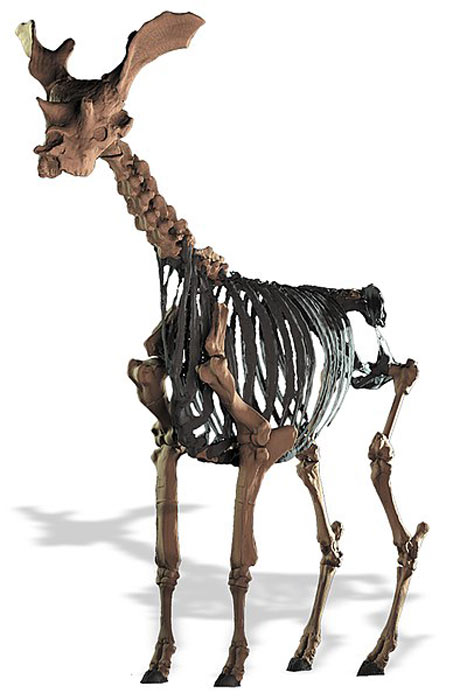
Digitally restored skeleton of Sivatherium giganteum from the Siwalik hills, India. (Basu et al/CC BY 4.0)
How could an animal of such ancient times slip through time and live on until the dawn of civilization? It sounds truly unimaginable, but evidence has appeared that tells us otherwise. Some of the earliest indications of this were found on ancient rock paintings in the Sahara and Central West India. These crude paintings show an animal much akin to a Sivatherium, suggesting that the animal actually went extinct as recently as 8,000 years ago!
But the main surprise came about during archaeological excavations of ancient Kish, a Sumerian city-state situated in the ancient cradle of civilization, Mesopotamia. A chance discovery offered tantalizing evidence that the Sivathere possibly survived to more recent times, particularly to the dawn of Mesopotamian civilizations and the first inventions of the wheel and the writing systems. The object in question was discovered during a joint archaeological expedition between the Field Museum and Oxford University in mid-1920’s: an elaborate copper rein ring created to fit onto the tongue of a chariot. This item was discovered in a deeper level and was dated to roughly 3,500 BC and lay alongside the remnants of a chariot and the skeletal remains of a horse.
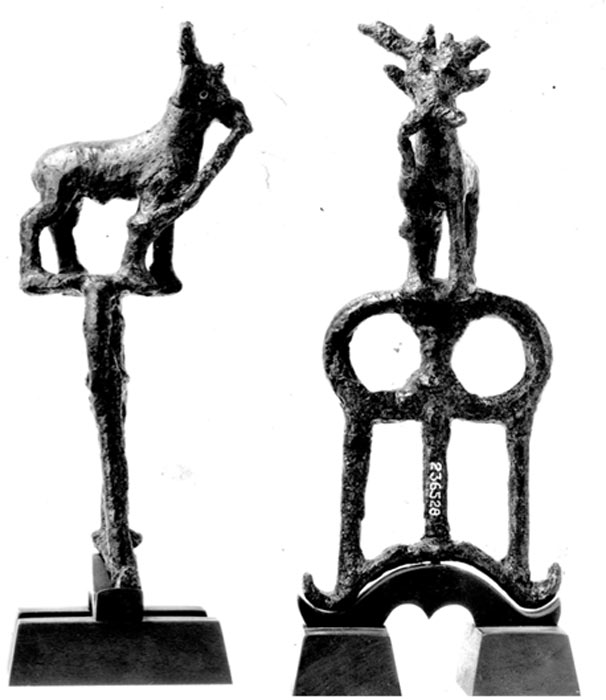
The so-called Sivatherium of Kish. (Field Museum of Natural History/CC BY-NC 4.0)
A Masterful Rendition of an Elusive Ruminant Beast
Granted, copper rein rings were discovered several times before that, and were not a novelty to archaeologists. In fact, they were commonplace, especially the ones dated to that era. However, one thing made this find stand out: and that was the animal depicted on the ring.
Usually, rein rings from Mesopotamia depicted draft animals that we all know, chiefly horses and the like. But the one found at Kish showed an antlered ruminant that was totally unique - and oddly similar to a Sivathere! At first, researchers thought that the animal represented a stag, likely a Persian fallow deer (Dama mesopotamica), considering the similarity of the horns. Early researchers thought that the Sumerians tamed deer as well, using them to pull chariots, as written in the following statement:
“Copper rein rings were known from Kish heretofore, but the previous ones were surmounted by the figure of a species of Equidae or simply by metal loops for the reins. In this case the figure was an unsuspected member of the Cervidae, and a long and heavy rope from the animal's muzzle indicates that stags must have been captured alive and tamed by the early Sumerians.”
But following deeper examination, it became clear that what was discovered at Kish was no animal known today. The artist’s hands carefully recreated a unique animal - down to the smallest details. And what can be seen is awfully like a Sivatherium of old, which can be thoroughly reconstructed from fossil remains.
Chiefly, the proportions are totally different from that of a stag, especially in the representation of the body. The animal on the rein ring is clearly a ruminant and a giraffid, and not a stag. Of course, the most important telltale clue are the horns. Sivatheriums had unique double antlers with two smaller horns right above the eyes. The exact same has been reproduced in copper form here.
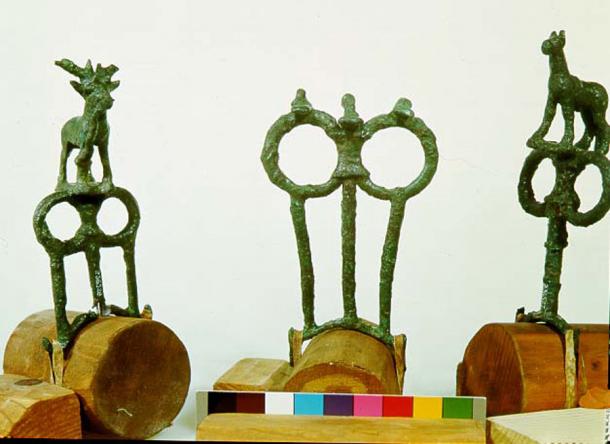
Ancient Sumerian copper (alloy) rein rings from Kish. (Field Museum of Natural History/CC BY-NC 4.0)
A Prehistoric Being Surviving Through Millenia
Could it be that a Sivatherium survived until 3,500 BC? Judging by the attention to detail, anatomical proportions, and the accuracy of the sculpted head, the metalsmith of Kish who created this fascinating and exquisite piece was not creating some imaginary fantastical beast. In fact, everything points to the fact that the artist saw the animal firsthand - and several times - thus knowing very well what to sculpt. If this curious object is solid proof that the Sivatherium existed in ancient Sumer, then the modern narrative on the creature is thoroughly wrong. If this is the case, then it could be likely that a certain population of Sivathere survived in the region of ancient Mesopotamia and was known to the Sumerians.
However, when one looks at the area of Iraq today, one has to wonder how would a giraffid of old survive here? Today, the region is arid, sandy, hot, and dusty, without much vegetation whatsoever. The remnants of ancient city-states like Kish, Nippur, Lagash, Uruk, Ur, Eridu, and others, are now covered with nothing but sand. But five thousand years ago, the region was wholly different.
Kish was situated at the eastern edge of the vast region of Mesopotamia, also a part of the region called the Fertile Crescent. This was a vast arc of land watered by the powerful waters of the Tigris and Euphrates (and the Nile to the west), and one of the earliest cradles of civilization. Five millennia ago, rainfall was much higher in the region, and nothing was as arid as it is today. There was more greenery and vegetation, and an abundance of crops and food. It is no wonder that it was there that ancient hunter gatherer nomads first turned to a sedentary lifestyle, changing history as they did so.
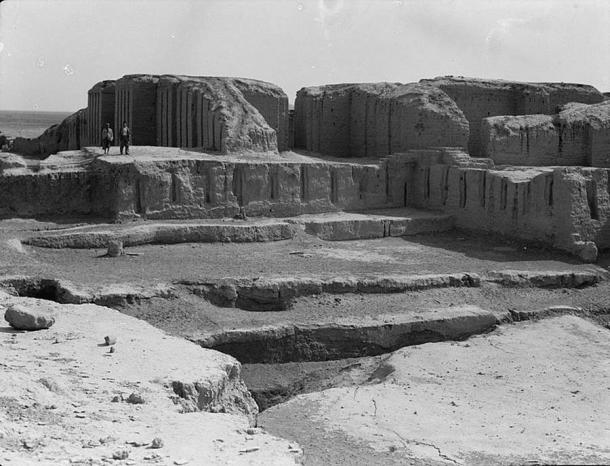
Kish as it looked in 1932. (Public Domain)
Thus, the valleys of Mesopotamia were once verdant and fertile, and could have been the home to isolated populations of Sivatherium. Undoubtedly, by 4,000 - 3,500 BC, such an animal would have been rare. You can imagine how awesome it would have seemed for the people of Sumer.
If it did actually exist at that time, then it would surely be considered a mythical beast, or an elusive draft animal reserved only for the most powerful of rulers. Adding to this theory is another unique detail of the copper Sivatherium rein ring. And that is an alleged rope attached to the animal’s snout. Could it be that the Sumerians managed to capture and tame a certain number of Sivatherium beasts? Were these powerful and very strong ruminants used as draft animals, or for pulling war chariots?
A Deer or a Sivatherium? The Discussion is Ongoing
In 1977, some 50 years after the “Sivatherium of Kish” was discovered, a German archaeologist and researcher, Michael Müller-Karpe, accidentally discovered some additional elements of the copper rein ring. While visiting, he discovered the broken-off tips of the horns that were thought lost. He found them in "a small box of dried mud in a Field Museum storeroom". These were recognized to be the missing tops of the Sivatherium horns, and they fit perfectly.
- Merrylin Cryptid Museum: Proof for the Existence of Mythical Beings or Elaborate Hoaxes?
- Searching for the Terrifying Mongolian Death Worm
- Is Bigfoot Real? Let’s Look at Emerging Scientific Evidence
However, many immediately argued that the being is, in fact, a fallow deer. This led to a string of discussions, and the scientific and archaeological world is still somewhat divided on the subject. However, evidence for this being a Sivatherium is in abundance. In his 1936 work on the topic of the rein ring, Edwin Colbert presented 7 valid points in defense of the “Sivatherium theory”. He lists them as follows (direct quote):
1. Sivatherium was a very large animal having body proportions similar to those of a large ox; that is, the limbs and the neck were not elongated as in the modern African giraffe. The figurine represents an animal with a normal ruminant body.
2. In Sivatherium the skull carried two sets of horn cores, a relatively small conical pair directly over the eyes and a large palmate pair at the back of the skull. This same arrangement of “horns” or “antlers” is shown by the figurine from Kish.
3. The small conical horn cores of Sivatherium are of frontal origin, and such would seem to be the case in the figurine.
4. The large, palmate horn cores of Sivatherium are of parietal origin, that is they are located on the occiput. In the figurine the palmate “horn cores” or “antlers” would certainly seem to be located on the back of the skull, as in Sivatherium, rather than on the frontals as is the rule in the Cervidae.
5. The posterior horn cores of Sivatherium are typified by inwardly projecting points at their bases, and the same features are shown in the figurine.
6. In the posterior horn cores of Sivatherium the bases are transversely broadened, and somewhat flattened on their anterior and posterior surfaces, giving them elliptical cross sections. A similar condition would seem to be shown in the posterior antlers of the Kish figurine.
7. In the statuette from Kish it would appear as if the nose is swollen and somewhat dependent, as might have been the case in Sivatherium, a genus characterized in part by its abbreviated nasal bones. On the other hand, it may be possible that the peculiar appearance of the nasal region in the statuette can be explained as the representation of a halter on the muzzle of the animal.
Alas, even today the question is open to discussion and examination. Some consider the Sivatherium theory a fringe, kooky, belief. But when faced with other similar discoveries, they quickly realize that the possibility is totally real.
One such find was made in the Algerian Sahara. Here, the Tassili n’Ajjer rock paintings were discovered, presenting many ancient animals. One of these was a peculiar and out-of-place giraffid, which seems to be a Sivatherium. Other discoveries include an ancient Hittite cylinder seal, also depicting a strange horned animal similar to a Sivatherium. Some 8,000-year-old petroglyphs in the Sahara also depict a similar being, and the list just goes on. Is this the evidence we need?
An Enigma That We Might Never Solve
Nevertheless, the question still remains a mystery. If there is a logical explanation behind the Sivatherium of Kish, the scientific world has yet to find it. And just like the enigmatic paintings of pygmy elephants from an ancient Egyptian tomb, the Sivatherium seems out-of-place and out-of-time, giving researchers a proper headache.
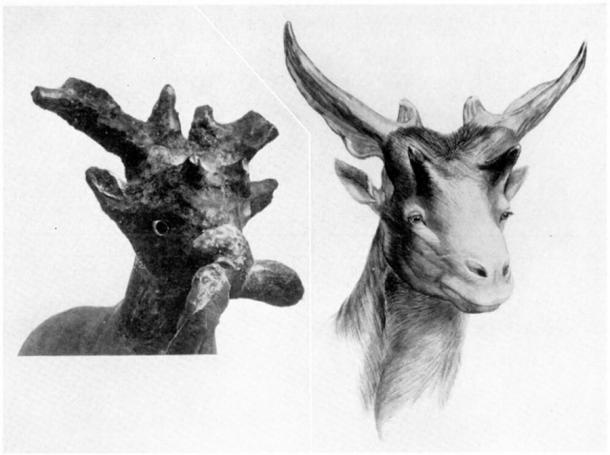
Left: Detailed view of the rein ring figurine found at Kish. Right: Reconstruction of the head of a Silvatherium giganteum. (Drawn by Margaret Matthew Colbert.) (Edwin H. Colbert)
In the end, we may never know the truth. After all, it could be simply a poor Sumerian rendition of a fallow deer. But then again, it could be an accurate rendition of a tamed Sivatherium. Either way, the question remains open to all. Just remember that the world can be full of wonders and surprises. We still don’t know for sure what beings lurk in the unexplored depths of the Amazon jungle, and other inhospitable, untouched places of this world. After all, one has to believe.
Top Image: The so-called Sivatherium of Kish (Field Museum of Natural History/Edwin H. Colbert) compared to a modern representation of a Sivatherium in the Warsaw Museum of Evolution. (Shalom/CC BY-SA 3.0)
References:
Colbert, E. 1936. Was The Extinct Giraffe (Sivatherium) Known To The Early Sumerians? American Museum of Natural History.
Eberhart, G. 2002. Mysterious Creatures: A Guide to Cryptozoology, Volume 2. ABC-CLIO.
Naish, D. 2011. What happened with that Sumerian 'sivathere' figurine after Colbert's paper of 1936? Well, a lot. ScienceBlogs. [Online] Available at:
https://scienceblogs.com/tetrapodzoology/2011/04/25/sumerian-sivathere-figurine
Piper, R. 2009. Dead as a Dodo. Scrubmuncher’s Blog.
Piper, R. 2009. Extinct Animals: An Encyclopedia of Species that Have Disappeared during Human History: An Encyclopedia of Species that Have Disappeared during Human History. ABC-CLIO.


















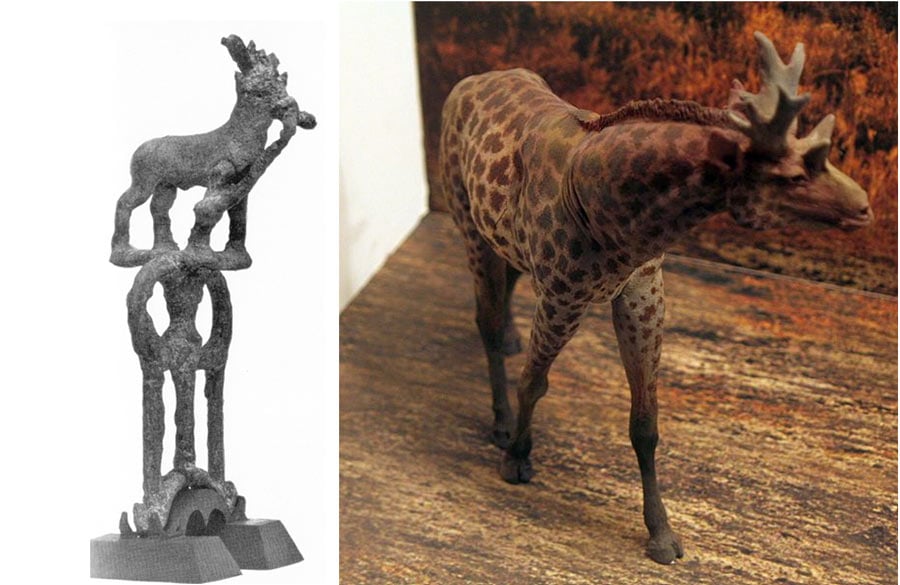

Comments
This is why we can’t always use the fossil record as irrefutable proof that an animal has gone extinct at a certain date, given how a low of a chance a body has to become a fossil in the first place. I think I read somewhere that it’s estimated that less than 1% of bodies become a fossil, or even have a chance of becoming a fossil. Didn’t we already learn this lesson with the coelacanth? I really hate the absolute cut-offs driven by standard archaeology and paeleontology. Just admit that they’re rough estimates and / or the best guesses given the evidence instead of preaching them as hard fact and irrefutable dogma. There’s always the chance the fossils do indeed exist, we just haven’t found them yet. Or we have found them but they’ve been misidentified, possibly even wrongly dated. I’m not saying there are T-Rexes still stomping around, I’m just saying that they could be a little more accepting that certain prehistoric mammals may have existed until far more recently.
That being said, this is fascinating. I’d certainly never heard of this before, even though it’s a debate that’s around 100 years old at this point. Prehistoric mammals always interest me, because they’re so rarely talked about. Even though there’s very good chances that earlier humans interacted with them. All you really hear about are the wolly mamoth and the mastadon. Maybe the saber-toothed tiger and the direwolves. Which is too bad, because a lot of them are so much more interesting.
WaaHooo! Boy O boy did this ring my bell! Supposed to be extinct? Mmm. According to Graham Hancock the Toxodon was also supposed to be extinct. Yet he found no fewer than 46 representations of them in Tiahuanaco, and again in Gobekli Tepe on a pillar. Of course this is not proof a Sivatherium existed in Kish, but I think it's possible that some animals didn't go extinct as early as we thought. After all we have some that never did. The Field Museum in Chicago? I had the privilege to poke around there and the Oriental Institute in 69-71 while ditching school while my dad was getting his PHD at UofC. I was just a delinquent adolescent, but museums were the only thing that interested me before I ran off to cowboy since. A consevator at the Feild Museum took a shine to my interest. He was working on the Cahokia mounds exhibits. So I got to go behind the scenes and see how places like this work. I can just imagine them finding the antler peices of the Sivatherium in a dried mud box..lol. It's said that the rein ring was found with the skeleton of a horse. Not to down on such acclaimed scholars, but who woulda thought to look for anything else? Though I spent the last 50yrs cowboyin, and shoeing horses, I've been blessed to be able to not just see, but touch dromadary, bactrans, zebras, and even trim hoofs of elephant (that was cool). I also have a great deal experience training horses and driving them. And any other critters I could harness.( Sh*t& giggles) So I just can't imagine a Sivatherium couldn't be rode or drove. There's a hand that rides a bison at the rodeos. Seen at the Denver Stock show. Also knew a guy in Rico, Colorado that rode a cow elk in the Delores parade a couple years. Ain't nuthin less domesticated than that. I'm guessing a Sivatherium would probably weigh a ton, maybe more. But I shod a lot of Belgian and Percheron that big. I'm not sure they really know if a Sivatherium is giraffe or camel or deer. The skeleton sure shows an awfully small ospedis to be as heavy as a bactran camel. But clearly an artiodactle. Nobody knows. Sure be interesting if the Field Museum kept the 'horse' skeleton found with the rein ring, and reexamined it. Mighty mystery !!
Has the metal been analyzed? One could probably learn more from that than speculation about interpreting the artist’s intent. Sure would be interesting if the copper turned out to be from Isle Royal, or maybe they would rather not know.